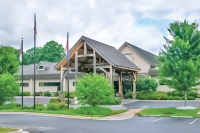Bury Ed in Appalachia
By Brett Martin
Western North Carolina is rich with great literature written on the region, and there are still a few jewels that have gone largely unnoticed or are forgotten. One of these would have to be Eliot Porter’s Appalachian Wilderness: The Great Smoky Mountains that included a “Natural and Human History” by the late Edward Abbey and was published in 1973.
Abbey, who had recently completed a one-year teaching assignment at Western Carolina University, had gained acclaim for his earlier work, Desert Solitaire, a gorgeous and poetic rendition of his observations as a park ranger in Utah. Such works as this, and later works such as The Monkey Wrench Gang, eclipsed Abbey’s Appalachian roots, but this essay in Porter’s stunning photographic collection of the park remains as one of the most lyrical and passionate pieces of modern writing on Appalachia. Perhaps most relevant for today is that it was, and remains, prophetic.
Abbey begins his essay with two words: Coming Home. From there follows a brief but vivid recollection of his Allegheny Appalachian childhood where he spent winter Sunday mornings firing the furnace at his family church, lost in a meditative ramble as he looked out at the “dark dank earth,” at the moisture-laden Appalachian mountains wrapped in a “diaphanous veil that conceals nothing.” His connection to Appalachia thus established, he begins a rich and eloquent diatribe that consisted of several days worth of travel throughout the Great Smoky Mountains National Park and the surrounding communities. His approach route to Gatlinburg is uncertain, but along the way he describes stripped hillsides, litter-filled ditches, abandoned country stores, and what he perceived then as the beginning of the end of a landscape that had taken hundreds of millions of years to create.
He describes Gatlinburg as “everything designed by a neurotic suffering from a severe case of social irrelevance.” Leaving Gatlinburg, he enters the park at Sugarlands, stopping to ponder the nation’s first traffic light in a national park (there’s a bit of new Smokies trivia for you). Abbey is there in December, so the traffic is light but his imagination is filled with the hordes of his memory and imagination. His conclusion: Let the machines have their own National Park and keep out of ours.
Admitting his own self-contradiction, he drives on to Alum Cave Bluff trailhead, where he enters the park during light snowfall. Standing at the magnificent overhang that lies within one of the most spectacular settings of the park, he decides that the National Park System is one of the very few decent things that the U.S. government has ever provided for ordinary citizens. To quote: Nearly all of its other activities, carried on at our expense, are for the benefit of the rich and powerful, or for the sake of the secret, furtive, imperial causes that can inspire in us feelings only of sickness, shame, and dread.
This is classic Abbey, and profoundly relevant to our current condition in the early 21st century. Abbey loved America, loved the land, but was harshly critical of capitalism’s numerous inequities and mindless march onward towards an indefinable future. Famous for his quote, “Growth for the sake of growth is the ideology of a cancer cell,” Abbey viewed the harvesting of Appalachia’s resources as a colonial expedition that would end in shambles. Mired in war, obesity, ecological devastation, and motorcycles that break the sound barrier, we can look back at Abbey’s observations 35 years ago and consider his evidence. For a baseline comparison that would be easily upheld through any legal challenge, he pulls out none other than William Bartram, whose lush descriptions of the area’s beauty are renowned. Bartram, of course, arrived in Western North Carolina in 1775, almost 200 years before Abbey and not long after a major campaign of the French and Indian War had laid waste to the Middle Town Cherokees within the Little Tennessee Valley. It was the beginning of a major uninterrupted alteration of the landscape that has only grown in force and political legitimacy.
Abbey’s descriptions of the area can be as eloquent as Bartram’s, and as equally filled with the melancholy that has settled into every crevice of these mountains for the last few hundred millions years of living, dying, and decay. Overlaying this is the difficult establishment of the Great Smoky Mountains National Park and the resistance by timber interests, hotel and lodge operators ensconced within its proposed boundaries, and the multi-generational mountain families who had made its dark hollers a home.
He decries the overuse of the park (remember, this was 35 years ago), the potential threat to the park’s ecology by the North Shore Road (still alive and well?), and his observation that the greatest problem facing the park is overuse. His solution: Expand the park by buying more land or by banning cars and all other forms of motorized transportation in it.
Abbey’s diatribe against cars in the park — Roads shrivel parks — is underpinned by his sarcastic opinion that the tourist towns will make more money than ever, as the crowds will come anyway, and stay even longer, as non-motorized tourism will result in healthier forms of recreation and in turn the tourists will eat and drink more.
Abbey’s final destination is Sylva, of which he is no less kind, decrying the grimy streets and foul smelling air, “the sky a pall of poisonous filth, ... the river is a sewer.” He blames the mill and he blames the growth, along with the failure of capitalism to protect our natural resources. Look about you and see what it has done to our country. I don’t know. One suffers from hope. Maybe we can learn something from what we have done to this land. Probably not. And in any case, is it any better elsewhere? Abbey despised the excesses of our nation, but only because he loved it — a brand of patriotism and outrage that we have grown less and less tolerant of.
Abbey’s final work, the fictional but autobiographical, The Fool’s Progress, documents his return to his northern Appalachian home at the end of his life. His body, however, was buried in an unmarked grave in his beloved desert, in a location known only to a few. I like to think though that his spirit is here in these lonesome and ancient Appalachian hills, where we must guard it and continue to bestow it upon the youth of Appalachia. If we are not to lose the soul of the region, we must.
(Brent Martin lives in Franklin and works for The Wilderness Society. He can be reached at This email address is being protected from spambots. You need JavaScript enabled to view it..)





